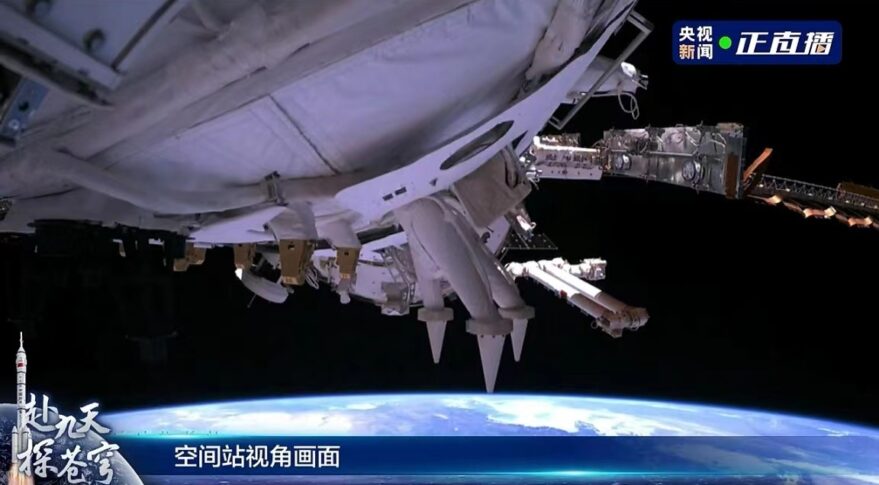
Shenzhou-14 crewed mission arrives at Chinese space station (Image Credit: Space News)
HELSINKI — China’s Shenzhou-14 crewed spacecraft docked with the Tianhe space station module early Sunday, marking the start of a crucial six-month-long mission.
Shenzhou-14 completed a fast automated rendezvous and docking with the Tianhe module at 5:42 a.m. Eastern, June 5, marking the safe arrival of astronauts Chen Dong (commander), Liu Yang and Cai Xuzhe.
The Long March 2F rocket carrying Shenzhou-14 and the three astronauts lifted off from the Jiuquan Satellite Launch Center at 10:44 p.m. Eastern Saturday. The spacecraft completed docking with the nadir, or Earth-facing, port of the Tianhe docking hub just under seven hours after launch from the Gobi Desert.
Also docked with the 16.6-meter-long, 4.2-meter-diameter Tianhe is the Tianzhou-4 cargo spacecraft, launched in May, containing supplies for the crew, along with propellant, science experiments and a number of CubeSats.
The Shenzhou-14 mission will, crucially, manage the arrival of two new 20-metric-ton-plus modules to the space station, namely Wentian and Mengtian, in July and October respectively.
“During the six months, we will be very busy,” Liu, who in 2012 became China’s first woman in space, said at a pre-launch press conference on Saturday. The astronauts were separated from the media by a screen, due to quarantine procedures.
“We will modify our space station from a single module into a three-module, three-spacecraft complex, during which three will be nine combination formations, five dockings, three departures and evacuations and two position changes.”
The missions will see the completion of the T-shaped, three-module Tiangong space station, a project initiated back in 1992.
Tianhe was launched in April 2021 and has so far hosted two crewed missions, Shenzhou-12 and Shenzhou-13, supported by the Tianzhou-2 and Tianzhou-3 logistics missions respectively.
“We will enter Wentian and Mentian lab modules for the first time,” Liu said. “We will conduct extravehicular activities with the aid of an airlock and robotic forearm, and carry out the combined operation of the [Tianhe] large arm and [Wentian] small arm.”
The crew will also complete a high number of scientific experiments and hold science outreach events, Liu added.
Chen, 43, first went to space on the month-long Shenzhou-11 mission to the Tiangong-2 test lab in 2016. Liu, 43, flew on Shenzhou-9 to visit Tiangong-1, while Cai, 46, is embarking on his first mission.
The new airlock cabin in Wentian will become the main exit-entry point for extravehicular activities (EVAs) once active. The Shenzhou-12 and Shenzhou-13 crews have so far used Tianhe’s docking hub for EVA entry and exit.
China’s first human spaceflight mission, Shenzhou-5, reached orbit in October 2003. Shenzhou-14 is only the ninth crewed mission launched by China in almost two decades, but the country is now committing to rolling six-month-long missions to the Tiangong space station for at least a decade.
Shenzhou-14 will handover to the Shenzhou-15 mission, expected to launch in December, when Tiangong will briefly host six astronauts for the first time.
Tiangong is designed to operate in orbit for at least ten years. It could be extended to six modules and host international astronauts.
China is also considering making the station available for tourist visits and will open Tiangong to commercial missions.
The country also plans to launch a co-orbiting optical telescope module, named Xuntian, in late 2023. It will be capable of docking with Tianhe for repairs, maintenance, refueling and upgrades, and aims to survey 40 percent of the sky across a decade.
Xuntian features a two-meter-diameter aperture and a field of view more than 300 times greater than the 32-year-old Hubble Space Telescope.
Russian officials have stated an interest in deeper human spaceflight cooperation with China while threatening to end its involvement in the International Space Station.
However, the 41.5 degree inclination of the Tiangong space station makes it very difficult for a Soyuz to launch to Tiangong from Russian territory, while ESA’s Kourou, which was being considered for hosting crewed Soyuz missions, is no longer available to Russia in the wake of its invasion of Ukraine.








